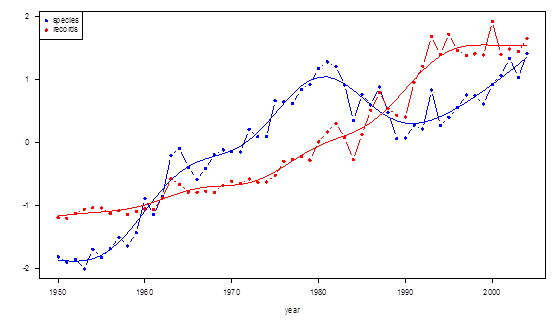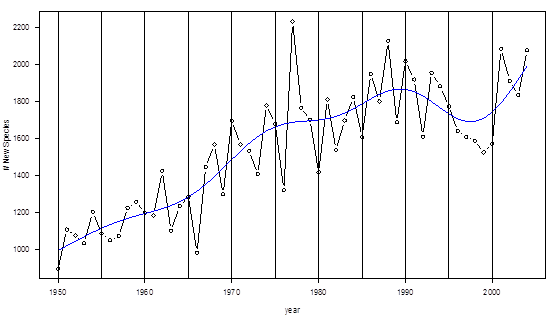Difference between revisions of "Ecosystem Approach Community of Practice: Trendylyzer"
| Line 35: | Line 35: | ||
## Species with IUCN status in < n MPA | ## Species with IUCN status in < n MPA | ||
## Edge effect; MPA near species distribution extension | ## Edge effect; MPA near species distribution extension | ||
| − | |||
| − | |||
; Priority to CoP | ; Priority to CoP | ||
: List proposed solution priority following the iMarine Board priority setting criteria: | : List proposed solution priority following the iMarine Board priority setting criteria: | ||
:* Potential target community; | :* Potential target community; | ||
| − | The OBIS EA-CoP expects interest from marine biologists, ecologists, environmental scientists, policy makers and planners, and environmental managers. | + | The OBIS EA-CoP expects interest from marine biologists, ecologists, environmental scientists, policy makers and planners, and environmental managers. Trendylyzer was already presented at the IMDIS 2013 conference in Luca. |
:* Users; | :* Users; | ||
Data managers, data analysts, and reporters in charge of providing overviews in trends and data on marine species distributions. | Data managers, data analysts, and reporters in charge of providing overviews in trends and data on marine species distributions. | ||
| Line 50: | Line 48: | ||
:* Referred in DoW; | :* Referred in DoW; | ||
:* Business Cases; | :* Business Cases; | ||
| − | The functionality is in support of BC2 | + | The functionality is in support of BC2 and 3 |
:* How does the proposed action generally support sustainability aspects; | :* How does the proposed action generally support sustainability aspects; | ||
| − | The OBIS community | + | The OBIS community is in need of analytical tools to assist the biodiversity community in understanding gaps and opportunities in the unique OBIS historic data set. This will help attract users, and thus increase the potential for funding to OBIS. |
| − | :* How consistent it is with EC regulations/strategies (eg INSPIRE); | + | :* How consistent it is with EC regulations/strategies (eg INSPIRE); Not considered |
:* Re-usability – benefits – compatibility; | :* Re-usability – benefits – compatibility; | ||
The service builds on top of already delivered functionality: | The service builds on top of already delivered functionality: | ||
| Line 61: | Line 59: | ||
* the Statistical service, | * the Statistical service, | ||
* the Map Discovery Services, | * the Map Discovery Services, | ||
| − | |||
; Parentage | ; Parentage | ||
Latest revision as of 17:41, 8 October 2013
- Product request
TrendyLyzer will apply long-term trend analysis on the OBIS data; what historic trends can we discover in the occurrence data. The expectations are similar to what can be achieved through trendalyzer / gapminder, and indeed, these should be considered as valid alternatives, where the e-InfrastructureAn operational combination of digital technologies (hardware and software), resources (data and services), communications (protocols, access rights and networks), and the people and organizational structures needed to support research efforts and collaboration in the large. would have a role in accessing and pre-processing the data to analyze.
The EA-CoPCommunity of Practice. expects that these requirements can be fulfilled through a Virtual Research EnvironmentA ''system'' with the following distinguishing features: ''(i)'' it is a Web-based working environment; ''(ii)'' it is tailored to serve the needs of a Community of Practice; ''(iii)'' it is expected to provide a community of practice with the whole array of commodities needed to accomplish the community’s goal(s); ''(iv)'' it is open and flexible with respect to the overall service offering and lifetime; and ''(v)'' it promotes fine-grained controlled sharing of both intermediate and final research results by guaranteeing ownership, provenance, and attribution.. This would allow the OBIS customers to access the data through the e-InfrastructureAn operational combination of digital technologies (hardware and software), resources (data and services), communications (protocols, access rights and networks), and the people and organizational structures needed to support research efforts and collaboration in the large., specify filters and groupings, select a statistical analysis model, adjust the algorithm parameters (if any), and monitor the progress. The results shall be representable in a variety of formats, and the selection of data, the algorithm and the result shall be contained in a report.
Current questions include:
- What are the most common species (10 - 25 or n) reported in OBIS?
- Filtered by
- Absolute
- Per year
- Per taxon
- Corrected by effort (No duplicates in space and time)
- By area
- By age / life stage
- Vizualized as
- Table
- Line chart
- Bubble chart
- Filtered by
- Are we observing more or fewer species (on the basis of species observed per 1000 records or per dataset) per year? Fig 1
- Absolute trend
- Trendlines
- Per taxon
- Are we reporting species that were previously not in OBIS (fig2), and next
- New species per period
- New species per area
- New species per taxon
- how long does it take from a species description to observation?
- WoRMS description and OBIS observation
- Filter on taxon (Family level downward)
- Filter on area
- Species Status tables (Using MPA shapes from UNEP WCMC; see Geospatial Cluster)
- Species with IUCN status per MPA (from WoRMS WS or IUCN)
- Endemic species per MPA (nr and occurrences)
- Species with IUCN status in < n MPA
- Edge effect; MPA near species distribution extension
- Priority to CoPCommunity of Practice.
- List proposed solution priority following the iMarine Board priority setting criteria:
- Potential target community;
The OBIS EA-CoPCommunity of Practice. expects interest from marine biologists, ecologists, environmental scientists, policy makers and planners, and environmental managers. Trendylyzer was already presented at the IMDIS 2013 conference in Luca.
- Users;
Data managers, data analysts, and reporters in charge of providing overviews in trends and data on marine species distributions.
- Potential for co-funding;
At this stage, no effort was made to identify co-funding sources. There seems some potential.
- Structural allocation of resources;
- Referred in DoW;
- Business Cases;
The functionality is in support of BC2 and 3
- How does the proposed action generally support sustainability aspects;
The OBIS community is in need of analytical tools to assist the biodiversity community in understanding gaps and opportunities in the unique OBIS historic data set. This will help attract users, and thus increase the potential for funding to OBIS.
- How consistent it is with EC regulations/strategies (eg INSPIRE); Not considered
- Re-usability – benefits – compatibility;
The service builds on top of already delivered functionality:
- the Species Discovery Service,
- the Statistical service,
- the Map Discovery Services,
- Parentage
- Relation to CoPCommunity of Practice. Software
The tool will depend on the EA-CoPCommunity of Practice. administered OBIS database.
- Relation to D4S technologies
Tickets in support to the realization of the functionality are :
Visualisation Use Case: Quantitative properties
- Productivity
- Are the proposed measures effective?
- Does it reduce a known workload?
- Presentation
- How must the component be delivered to users? (UI Design / on-line help / training material / support)
- Policy
- Are there any policies available that describe data access and sharing?
- Have the Copyright / attribution / metadata / legal aspects been addressed from a user and technology perspective?
- A detailed policy page as proposed in iMB3 can be described Use_Cases_for_EA-CoP_Data_Access_and_Sharing_Policies#TRENDYLYZER
- Figures

